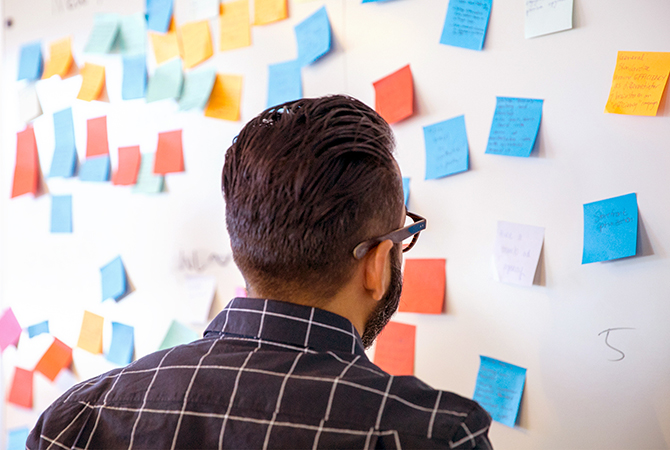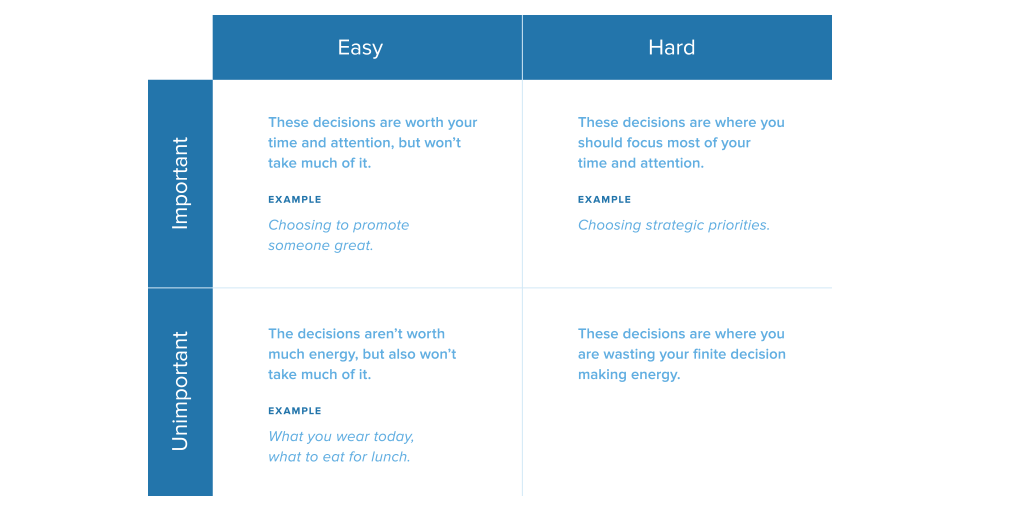Just pick something! (avoiding decision fatigue at work)

Many of us think of time as our most scarce resource, but it’s really energy — particularly when it comes to decision making. Our brains get tired when we work them too hard, and then they get lazy. That’s when decision fatigue and bad decisions happen. If you’ve ever purchased a candy bar in the checkout line at the end of an hour of careful shopping, in spite of your better judgment, you were probably falling victim to this effect.
Leaders have to make a ton of decisions every day, and wise leaders know that they have to be thoughtful about how much energy to put into each one. Ideally, they put all their focus on the most important decisions that require serious thinking. That’s why President Obama wears the same suit every day.
Easy decisions rarely take much effort, regardless of whether or not they are important. However, we’re often prone to killing ourselves over hard decisions that aren’t actually that important. In fact, their lack of importance is often what makes them hard, because the overall expected value for the company is actually similar between the two options.
For example, one choice might take longer, but also result in more revenue; if you go that way, you can spend the extra money on something that will save you time elsewhere. If different options lead to very different outcomes for the company, the right decision is usually (but not always) obvious.
When two options have similar expected values, don’t sweat them, because it doesn’t matter which you choose.

A recent example at Asana of a decision where the two options likely had similar outcomes was figuring out seating charts. Should people be grouped by program teams, so that everyone who is working on the same project can quickly communicate? Or by function, so that everyone who does the same kind of work can easily critique each other’s work or provide help with tricky problems?
The former optimizes for agility and coordination, whereas the latter optimizes consistency and mentorship. In some cases, one of those optimizations is truly important, but for most projects and teams, either is fine as long as you don’t totally neglect the other (e.g. if you organize by program team, you should make sure to have a regular meeting for people in the same function to facilitate collaboration between projects). Just pick one. In this case, it is even acceptable (and perhaps desirable) to consider reversing the decision periodically to get the best of both worlds.
Done is better than perfect: bias for action
In case you needed additional motivation, remember that letting decisions linger has a number of negative consequences:
- It creates cognitive overhead for the decision maker, who spends both conscious attention on it and unconscious energy (“background processing”) while they go about other activities.
- It results in the paradox of choice phenomenon, meaning you’re less likely to be satisfied with the ultimate decision regardless of which way it goes.
- It creates anxiety and confusion within the team, who are either blocked on dependent decisions or forced to plan out contingencies.
How do you know which kind of decision you have in front of you?
As with many aspects of teamwork, the easiest way to overcome this problem is mindfulness: make sure you are explicitly asking the question, “is this decision important?” Ask yourself, ask your boss, and ask your team. You’ll be surprised how often the answer is a simple, unambiguous “No.” Sometimes, you’ll still end up regretting the decision that you made, but that’s ok because it was never important in the first place. Save your regret energy for when it counts, too.
You can also proactively help your colleagues reach this understanding. The GiveWell team is so practiced at this they use a custom emoticon ![]() to simply mean “TMI; you decide!”
to simply mean “TMI; you decide!”
If you’re unsure, do a quick visioning/anti-visioning exercise:
- What’s the best that could happen if this decision is made well?
- What’s the worst that could happen if the decision goes poorly?
If the gap between outcomes is small, just make a call. If, however, there’s a big gap between the potential outcomes, it’s a good sign that the decision is worthy of more thought.
Making decisions is an energy-draining exercise. Be careful to spend that energy where it will be most leveraged and avoid decision fatigue.
More Issues
